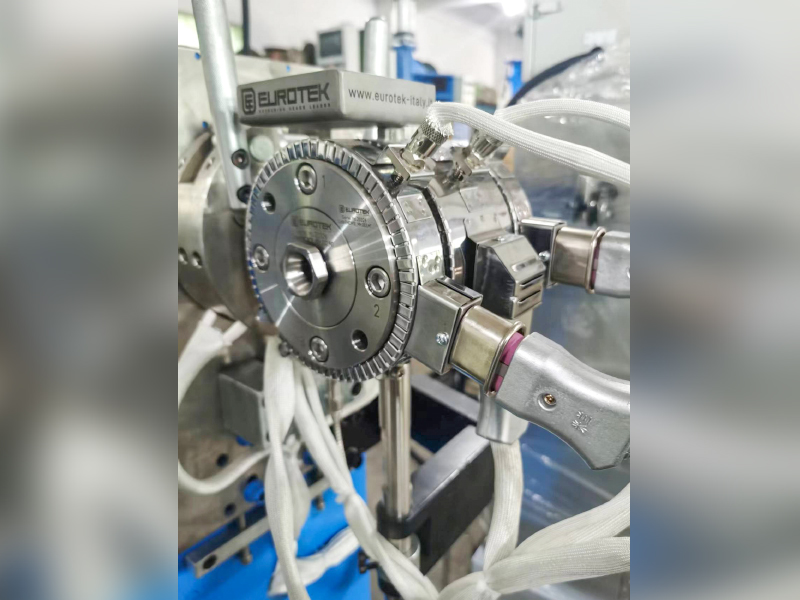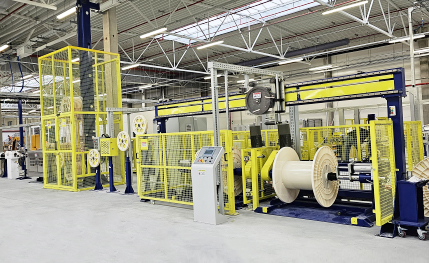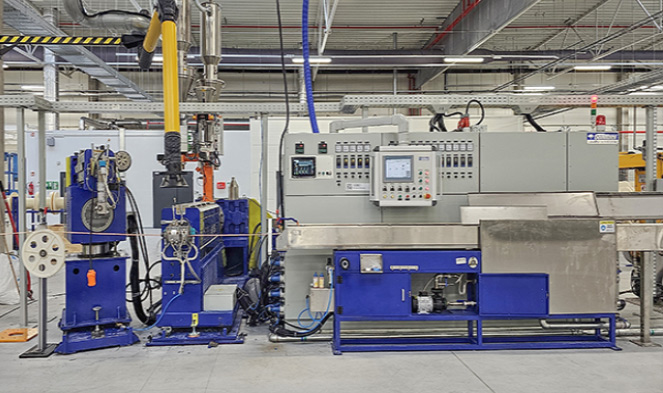 Product Category
Product Category
During taping process, the core wire and tape pay off separately. Then, tape material is wrapped around the core wire with stable tension to form a wire. For the ordinary taping machine, magnetic powder clutches are selected as tension elements. As the rotor of the clutch and the magnetic powder are of contact structure mechanism, the frictional heat energy generated during high-speed rotation causes the tension output of the magnetic powder clutch to be unstable. In addition, after the magnetic powder is used for a period of time, the magnetic force will decrease or even disapear, resulting in a smaller torque generated on the taping head and further influencing machine’s normal production. The magnetic powder needs to be replaced regularly, and it makes maintenance troublesome and costly. In order to solve such problems, this machine uses a hysteresis clutch as the tension element to replace the original magnetic powder clutch. The hysteresis clutch consists of a hysteresis stator and rotor. When the coil of the hysteresis stator is charged, an electromagnetic field is generated in the annular space of the hysteresis stator. When the hysteresis rotor rotates, it cuts the electromagnetic field to generate resistance (torque). This torque acts on the strip material as the tape tension. Since the hysteresis rotor does not have a mechanical contact with the hysteresis stator when rotating, no mechanical friction heat energy is generated, thereby achieving stable tape tension output. By adjusting the hysteresis stator current, different torques can be outputted, thereby achieving tension adjustment with simple, compact and durable structure.
Establishment time
Building area (m²)
Number of employees
Intellectual property
 A Mature Factory You Can Count On
A Mature Factory You Can Count On
 2025-12-29
2025-12-29
 Webmaster
Webmaster
Although an extruder machine looks like a bulky, heavy metal cabinet, its internal structure is very sophisticated. We can imagine it as a "superheate
Read More +
 2025-12-22
2025-12-22
 Webmaster
Webmaster
The working process of an extrusion machine is similar to squeezing toothpaste or using a piping bag to decorate a cake. It uses pressure to force sof
Read More +
 2025-12-15
2025-12-15
 Webmaster
Webmaster
In fields such as plastics, metals, and food processing, extrusion machines can be primarily classified into the following categories based on their w
Read More +
 2025-12-08
2025-12-08
 Webmaster
Webmaster
Here's a of extrusion machine parts: 1. Material Funnel (Hopper) What it does: The top chute where operators dump plastic pellets, rubber crumbs, or p
Read More +
 2025-12-01
2025-12-01
 Webmaster
Webmaster
Here's what an extrusion machine operator does daily: 1. Setting Up the Machine Prepares materials: Loads plastic pellets, rubber, or powders into
Read More +
In the field of electrical equipment manufacturing, hysteresis tension type wire taping machines represent the cutting edge of winding precision. Gemwell Electrical Technology (Jiangsu) Co., Ltd., leveraging its deep integration of electromagnetic technology and precision mechanics, has developed this equipment as a core process enabler.
I. What is the core principle of hysteresis tension control? Why is it the cornerstone of precision winding?
This tension control system is based on the unique physical properties of hysteresis materials. When a wire passes through a specially designed hysteresis brake, the system doesn't rely on simple friction or mechanical pressure, but instead utilizes the inherent energy loss characteristics (hysteresis loss) of hysteresis materials in an alternating magnetic field to generate a stable, slip-free braking torque. Gemwell Electrical Technology, with a deep understanding of this principle, uses precise material selection and magnetic field structure design to ensure that tension output is unaffected by wire speed fluctuations. This fundamentally eliminates the "slippage" or "overtightening" issues common with traditional mechanical brakes, laying the physical foundation for lossless winding of sensitive materials such as enameled wire and ultra-fine wire.
II. Why is constant tension so crucial to the performance of electrical components? How does Gemwell achieve this?
The electrical consistency (e.g., inductance and Q factor) and mechanical stability (resistance to vibration and thermal expansion and contraction) of winding coils are critically dependent on constant wire tension. Tension fluctuations can lead to: uneven tension between coil layers, causing abnormal distributed capacitance; microscopic deformation accumulation, reducing long-term reliability; loose windings or excessive embedding, which can affect heat dissipation and even cause inter-turn shorts. Gemwell's solution is a closed-loop tension control system: a real-time, high-precision sensor monitors actual tension, compares it to the preset value, and then dynamically adjusts it within milliseconds using a high-speed hysteresis brake/drive unit. This "sense-feedback-actuate" closed-loop logic ensures micron-level tension stability from the start to the end of winding, providing significant advantages under high-speed or rapid start-stop conditions.
III. How do precision wire routing and tension control work together? What is Gemwell's unique feature?
The ultimate goal of a winding machine is to achieve tight, uniform, and gap-free wire routing. This requires that the precise displacement of the wire-traversing mechanism (with guide wheels or leadscrews typically achieving micron-level accuracy) be perfectly synchronized with the spool's rotation and tension control. Gemwell engineers deeply integrated the tension control unit with a high-resolution servo wire-traversing system, developing a unique collaborative algorithm. This system dynamically compensates for wire-traversing pitch errors caused by subtle variations in wire diameter and increased spool diameter (the "taper effect"), while also counteracting inertial tension disturbances caused by acceleration changes. This enables stringent process requirements such as the ultra-tight spacing required for high-frequency transformer coils or multi-layer precision random winding.
IV. How to overcome the challenges of high-speed operation? What are Gemwell's technological breakthroughs in dynamic response?
While increasing wire speed improves efficiency, it also exacerbates the difficulty of tension control—factors such as inertia, vibration, and air resistance intensify their impact. Traditional mechanical or pneumatic tensioners exhibit significant response lag. Gemwell's hysteresis tension system, thanks to its non-contact operating principle and the inherently rapid electromagnetic response, offers excellent dynamic performance. The key lies in its core hysteresis drive module, which adjusts the excitation current within milliseconds, instantly changing the output torque and rapidly suppressing high-speed wire "jitter" or "surge." This ensures that tension ripple remains strictly within process tolerances even at winding speeds of several kilometers per minute.
V. How does intelligent operation and maintenance enhance equipment value? What is the practical significance of Gemwell remote diagnostics?
Modern high-end winding machines are no longer isolated machines but deeply integrated mechatronic systems. The remote diagnostic technology embedded in the Gemwell platform serves as the "nerve center" for equipment health management. An embedded sensor network continuously collects key parameters such as tension fluctuation spectrum, motor current harmonics, and bearing vibration, and combines them with big data models for status analysis and fault warning. If the system detects abnormal deviations in the tension feedback curve or a trend of declining brake unit efficiency, Gemwell engineers can remotely access the system to retrieve operation logs, perform software parameter calibration, and even provide on-site maintenance guidance, avoiding unplanned downtime. This capability is particularly valuable in the context of a globalized supply chain (such as during logistics disruptions during the pandemic), enabling customers to receive near-zero-wait technical support and maximizing production continuity.
The hysteresis tension type winding machine is not only a tool for forming wires but also a technological culmination of electromagnetics, material mechanics, and precision control engineering. By continuously exploring the application boundaries of hysteresis materials, optimizing closed-loop control algorithms, and integrating intelligent operations and maintenance systems, Gemwell Electrical Technology (Jiangsu) Co., Ltd. is unleashing the full potential of this precision equipment, making it a key enabler for ensuring the consistent performance and reliability of high-end electromagnetic components. Its technological evolution continues to set new standards for winding process precision.
